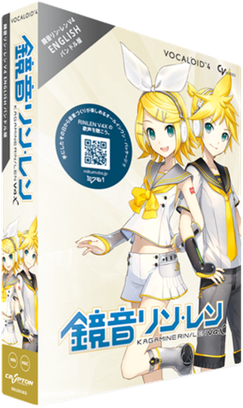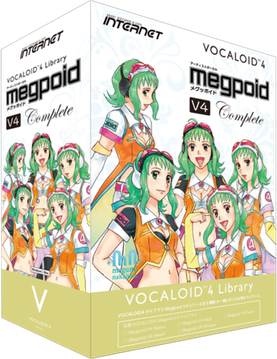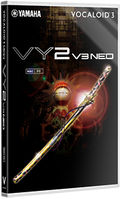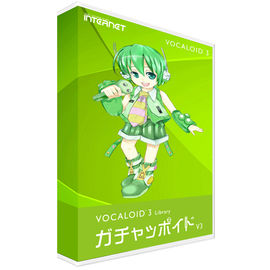
Yamaha Corporation is a Japanese musical instrument and audio equipment manufacturer.

Vocaloid is a singing voice synthesizer software product. Its signal processing part was developed through a joint research project between Yamaha Corporation and the Music Technology Group in Universitat Pompeu Fabra, Barcelona. The software was ultimately developed into the commercial product "Vocaloid" that was released in 2004.

Kaito is a Voice Synth developed by Yamaha Corporation for the VOCALOID1 engine, and distributed by Crypton Future Media. He has performed at live concerts onstage as an animated projection along with Crypton's other Voice Synth characters. His original codename was "TARO" back during "Project Daisy", the predecessor of VOCALOID, and was one of the original four known vocals for the project. His voice provider is Japanese singer Naoto Fūga. He was the fifth and final vocal released for the original VOCALOID software, and the second vocal released in Japanese.

Megurine Luka, codenamed "CV03", is a Vocaloid software developed by Crypton Future Media, headquartered in Sapporo, Japan. Its official moe anthropomorphism is a 20-year-old woman. She uses Yamaha Corporation's Vocaloid 2 and Vocaloid 4 singing synthesizer technology. Her voice is sampled from Yū Asakawa. She has performed alongside other Vocaloids at live concerts onstage as an animated hologram projection.
Crypton Future Media, Inc., or simply Crypton, is a Japanese media company based in Sapporo, Japan. It develops, imports, and sells products for music, such as sound generator software, sampling CDs and DVDs, and FX and BGM libraries. The company also provides services of online shopping, online community, and mobile content.

Internet Co., Ltd. or Internet, is a software company based in Osaka, Japan. It is best known for the music sequencer Singer Song Writer and Niconico Movie Maker for Nico Nico Douga, a video sharing website. It also develops singing synthesizers using the Vocaloid 4 engine developed by Yamaha Corporation. In 2014, they were the second leading company in sound-related software in Japan, boasting a 14.0% share of the market.

PowerFX Systems AB, commonly referred to simply as PowerFX, is a small recording company, based in Stockholm, Sweden. The company has been producing music samples, loops and sound effects since 1995. They also developed singing synthesizers using the VOCALOID engine developed by Yamaha Corporation.
Bplats, Inc. is an application service provider (ASP) based in Tokyo, Japan. The company offers software as a service (SaaS) and platform as a service (PaaS) solutions. It runs web portals on ASP, SaaS and cloud computing and an online store to sell software and hardware, such as the VY Vocaloid series.

Cantor was a vocal singing synthesizer software released four months after the original release of Vocaloid by the company VirSyn, and was based on the same idea of synthesizing the human voice. VirSyn released English and German versions of this software. Cantor 2 boasted a variety of voices from near-realistic sounding ones to highly expressive vocals and robotic voices.
anaROBIK is the name given to an electropop computer-generated female vocalist created by British programmer Robert Hedin and accompanied by American multi-instrumentalist Bobby Trempealeau of Minneapolis, Minnesota.
Vocaloid is a singing voice synthesizer and the first engine released in the Vocaloid series. It was succeeded by Vocaloid 2. This version was made to be able to sing both English and Japanese.

Vocaloid 2 is a singing voice synthesizer and the successor to the Vocaloid voice synthesizer application by Yamaha. Unlike the first engine, Vocaloid 2 based its output on vocal samples, rather than voice analysis. The synthesis engine and the user interface were completely revamped, with Japanese Vocaloids possessing a Japanese interface, as opposed to the previous version, which used English for both versions. It is noteworthy for introducing the popular character Hatsune Miku. It was succeeded by Vocaloid 3.

Vocaloid 3 is a singing voice synthesizer and successor to Vocaloid 2 in the Vocaloid series. This version of the software is a much more expansive version, containing many new features, three new languages and many more vocals than past software versions combined. It was succeeded by Vocaloid 4.

Vocaloid 4 is a singing voice synthesizer and successor to Vocaloid 3 in the Vocaloid series. It was succeeded by Vocaloid 5.

Kagamine Rin & Len, officially code-named CV02, are a pair of Vocaloid software voicebanks developed by Crypton Future Media, headquartered in Sapporo, Japan. Their official moe anthropomorphism consists of a pair of twin 14 year old singers, a boy and a girl, respectively named Len and Rin. They use Yamaha Corporation's Vocaloid 2 and Vocaloid 4 voice synthesizing technology. Their voices are samples of voice actress Asami Shimoda. They have performed at live concerts together, as they are each other's mirrors.

Megpoid is a Vocaloid by Internet Co., Ltd. Her voice is sampled by Megumi Nakajima. The mascot of the software is called Gumi . She is also sometimes called Megpoid GUMI, or GUMI Megpoid.

VY2 is a Japanese masculine vocal developed by Yamaha Corporation and distributed by Bplats, Inc. to act as a "standard" vocal for Vocaloid. It has the codename of "Yūma". It was originally released for the Vocaloid 2 engine. The fan design "Roro" which is illustrated by song producer Manbou no Ane, is commonly used to represent VY2. VY2 also has a Falsetto Voicebank that allows users to make higher pitched songs with its voice. VY2's voice bank is often used with the VY1 voice bank.

Gachapoid is a software application based on the character of Gachapin. It was originally developed for Vocaloid 2. The mascot of the software is called Ryuto (リュウト) and he is sampled from the actress Kuniko Amemiya, who is the current voice of Gachapin.

Vocaloid 5 is a singing voice synthesizer and successor to Vocaloid 4 in the Vocaloid series. It was succeeded by Vocaloid 6.













